Military Issue: How Everyday Fashion Items Went From the Battlefield to the Streets

Actor Tom Cruise on the set of Top Gun. Photo by Paramount Pictures/Sunset Boulevard/Corbis via Getty Images
Despite the atrocities and horror of the two world wars of the 20th century, one unexpected after-effect is the lingering influence these conflicts have on the modern wardrobe. Certain sartorial items initially designed for soldiers on the frontline have been adopted by the fashion industry and continue to be wildly popular today.
From apparel like cargo pants and bomber jackets to accessories such as pilot watches and aviator sunglasses, these items were all created for the military, purely with function, durability and practicality behind their design ethos. Yet as the fashion industry has since commandeered these military essentials into their fold, intriguingly, their designs have remained virtually unchanged and true to their origins.
Sure, many designers often take inspiration from the military, and they might tinker with the design to ante up the luxe and style factor, but this occurs mostly when it comes to womenswear. A combat boot with stiletto heel or a camo print gown, anyone? But when it comes to menswear, it appears most males want all the original functionality, practicality and simplicity associated with these regulation military items. Authenticity and heritage are the coveted badges of style for today’s male.
The enduring popularity of such army attire could be attributed to several factors. Pop culture’s fascination with the two epic world wars is on-going. The Hollywood dream factory still churns out movies based on these events, helping to seal the status of soldiers’ sartorial looks as heroic and hyper-masculine. As Timothy Godbold, the author of Military Style Invades Fashion, says, “As long as there is war, conflict and political unrest in the world, I think military-style fashion will continue to be absorbed by popular culture.”
Also, there seems to be a steady stream of dead stock military garb up for grabs. Army surplus stores – still operating in urban cities – offer a wealth of authentic military merchandise left over from those eras at low price tags.
But a pivotal reason for the wide embrace of these items could be traced to some of the original companies that provided the military –both British and American – with these battle-ready staples. They are still very much in business but now as bona-fide fashion companies producing some of this authentic gear for the consumer market.
Two of these historic American companies – both more than 100 years old – watch brand Hamilton and outerwear manufacturer Schott NYC, recently joined forces to celebrate their common heritage as suppliers of watches and jackets to pilots in the U.S. Army during the Second World War. The two companies collaborated on a new timepiece, the Hamilton Khaki Pilot Schott NYC. Launched this fall, the limited-edition watch pays homage to Hamilton’s classic pilot watches. Schott produced the handmade leather bands and folding carrying cases in its Union, N.J., factory, using the same steer hide leather used for flight jackets in the Second World War, right down to the colour – Federal Standard military colour 30099 Earth Brown.
Such collaborations helps to keep the mystique, history and impact behind military garb burnished bright and from retreating into oblivion.
Jason Schott, the fourth generation behind family-owned Schott NYC, echoed a sentiment that companies with such a legacy would agree upon: “Our past is our future.”
Scroll through for a look at how past military items infiltrated men’s wardrobes.
PILOT WATCHES
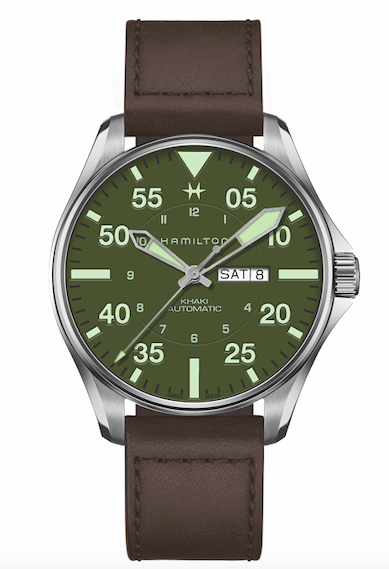
The Hamilton Khaki Pilot Schott NYC Limited Edition watch, $1,500, hamiltonwatch.com
The modern wristwatch has the military to thank for many of its features, which were developed during the two great world wars. Before the First World War, wristwatches were worn only by women, while men carried pocket watches. During the war, soldiers had the cumbersome task of trying to strap these pocket watches to their wrists.
As military watches developed, watchmakers were pressed to develop wristwatches with such characteristics as durability, reliability and luminosity. Hamilton developed a reputation for accurate watches in the early days of the American railways. And by 1918, their watches were being used in the skies by the U.S. Airmail coast-to-coast service. During the Second World War, they were supplying the U.S. military with more than one million watches over a three-year period during the 1940s. Some of their innovations over the years included producing the first electric watch powered by a battery.
The vintage-looking Khaki Pilot Schott NYC timepiece pays homage to the pilot watches they produced during the Second World War with an enlarged face and large numerals. With just 1,892 pieces produced – the number represents the year Hamilton was established and the birth date of Schott NYC’s founder, Irving Schott – it’s guaranteed to become a collectible and heirloom.
Canadian aerobatic pilot Pete McLeod, who also serves as ambassador for Hamilton and stars in the campaign, says this of the appeal of these retro-looking pilot watches: “Purposeful designs will always have a home.”
CARGO PANTS
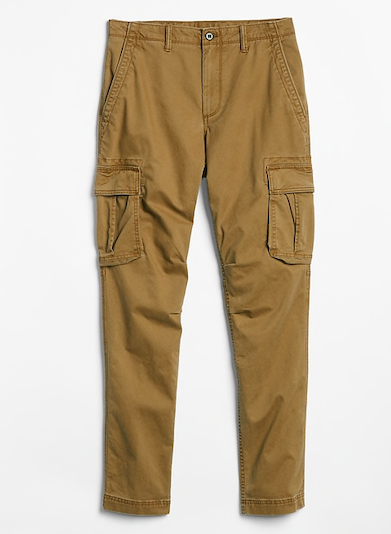
Cargo Pants with GapFlex, $80, gap.ca
Cargo pants were originally worn by British military personnel in the late 1930s and had only one side pocket on the thigh and one on the front hip. When the United States military adopted the cargo pant in the Second World War as part of their paratroopers’ uniform, they placed side pockets on both trouser legs, and these cargo pockets served as a place to hold extra ammunition, note pads and maps. By the time the Vietnam War arrived, cargo pockets became even more essential, as the American soldier was carrying more equipment and gear.
It was during the 1990s, thanks to hip-hop artists who wore baggy military cargo pants from surplus stores and retailers like Gap, cargo pants became fashionable. Today the practical pants have since climbed the luxury ladder, featured in designer collections and in more expensive fabrics. But the basic utilitarian cargo pants shows no signs of fashion fatigue.
THE WHITE CREW NECK T-SHIRT
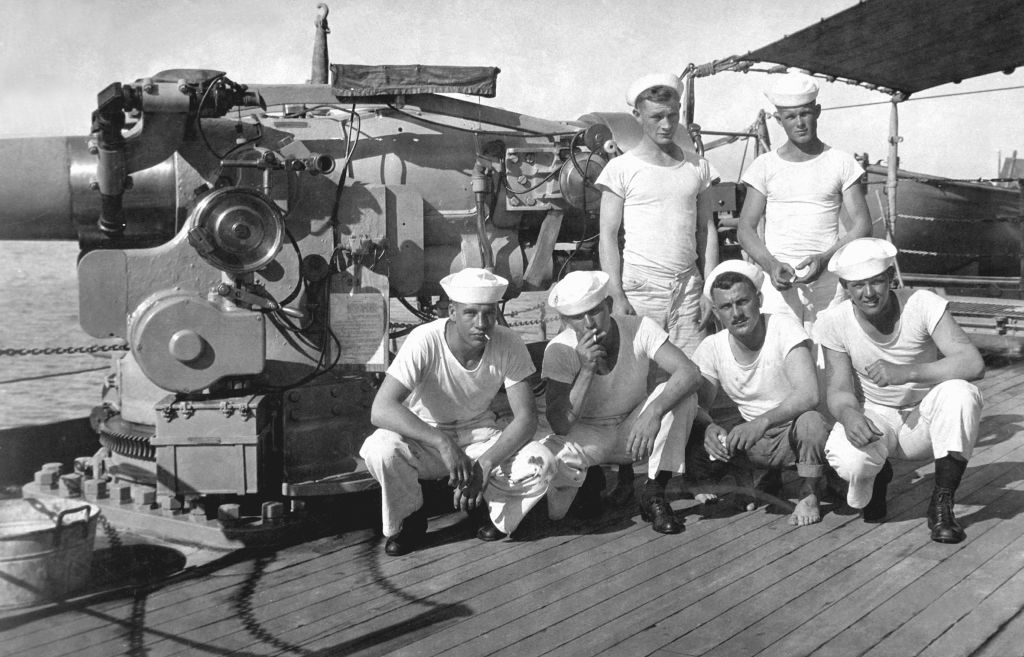
We have the U.S. Navy to thank for one of the most iconic fashion items. The white T was conscripted as part of their uniform in 1913, and Hanes was the supplier.
In the early 20th century, men’s undergarments were known as a union suit, essentially a onesie. Eventually manufacturers cut them into a top and bottom and the button-front henley was born.
But the U.S. Navy wanted a lighter material for the undershirts of servicemen stationed in tropical climates and those confined on submarines. Hanes stepped up with a short-sleeve, round neck, no-buttons, pull-on shirt. It was easy to wash and dry and it was not uncommon to see service men wearing these white T-shirts without their jackets as they worked.
This stretchy inexpensive jersey fabric soon inspired womenswear, leading Coco Chanel to use it to make dresses.
By the time the Second World War rolled around, the white T was standard issue in the military. Except this time, there was more media coverage with images in newspapers and television of troops off-duty in their white T-shirts, cementing its status as a garment of heroes. When the war ended and the men returned home, they brought along the white T but for the most part, it remained under clothes.
It took brooding heartthrob Marlon Brando in the 1951 film A Streetcar Named Desire, in a dirty white T and jeans, to single-handedly gave this plain utilitarian garment some sex appeal and changed the perception that this could be more than an undershirt. And by the time, James Dean showed up four years later in A Rebel Without a Cause wearing a white T and jeans, there was no more hiding the T-shirt undercover. It became a stand-alone outer garment, and thus began its journey into pop culture as billboard political statement and perennial fashion item.
AVIATOR SUNGLASSES
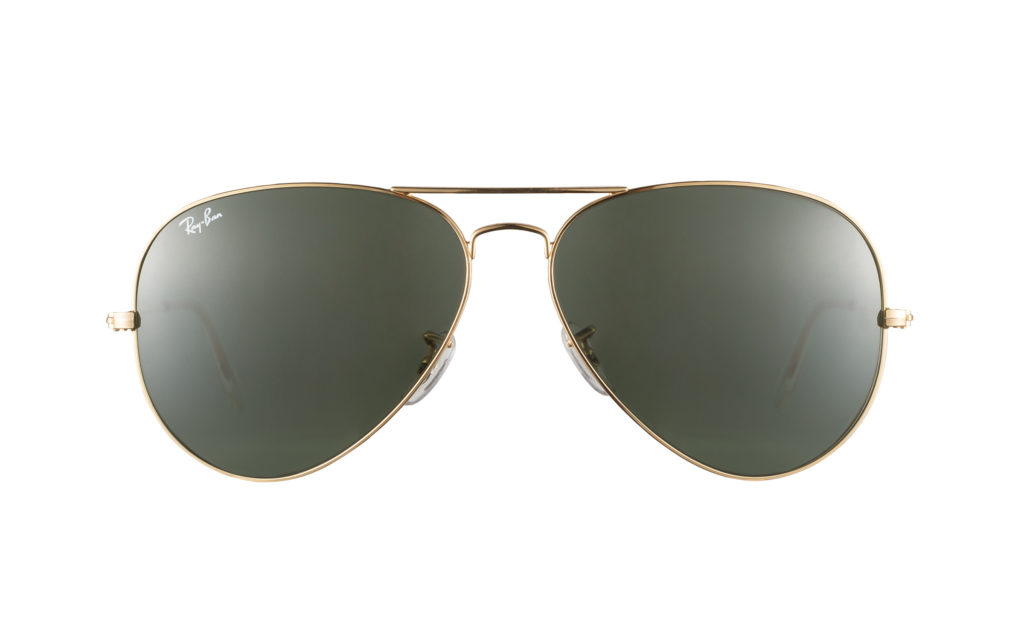
Ray-Ban Sunglasses, $193, clearly.ca
The aircrafts of the Second World War were flying higher and further than ever before, and military pilots began to complain of headaches and glare from the sun. Bausch & Lomb developed a sleek-looking pair of teardrop-shaped glasses that cut the glare. The slight convex shape helped protect the entire range of the eye, thus preventing as much light as possible from entering the eye. The now-iconic teardrop design was chosen because it was the same shape as eye sockets, which allowed a gas mask to go over the frames should an inflight emergency occur. (Incidentally, the shape is reportedly proven to be suitable to most faces.)
Created purely for function to help military pilots, Bausch & Lomb trademarked the sunglasses as Ray-Ban and a few years later started marketing them to the public.
The Aviator sunglasses began showing up on Hollywood stars as early as the 1950s, when Marlon Brando wore a pair in The Wild One. Over the years, aviators became the favourite sunglasses of celebrities from Elvis Priestley to Michael Jackson and Madonna.
And just when you think aviators could not soar any higher on the the cool thermometer, along comes Tom Cruise in 1986’s Top Gun. He reminded the public of the Ray-Ban Aviator beginnings with military pilots. But more importantly, it also said, these glasses were more than a fashion item – they was the real deal.
THE BOMBER JACKET
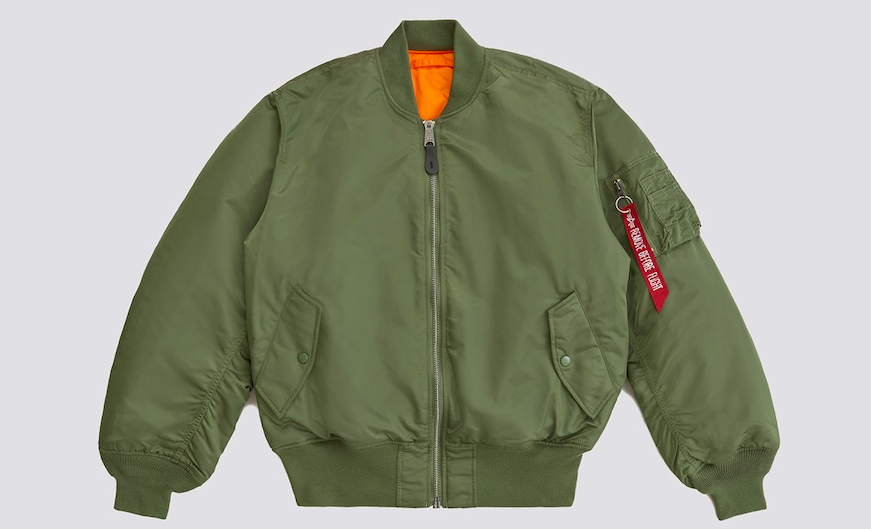
Alpha MA-1 Flight Jacket, $219, alphaindustries.com
The closest competitor to the jean jacket as an outerwear garment would be the nylon bomber jacket. The origins of this iconic item – known in the military as the MA-1 – can be traced back to 1949 and was a new type of aviator jacket design to match pilots’ needs with the new advancement in aircraft technology. Cockpits were now better insulated, sleeker and more compactly designed. Previously, pilots wore bulky flight jackets made of seal skin or leather and lined with fur to keep warm in the open air, uninsulated cockpits of fighter planes.
The aviator jacket evolved by the time the Second World War rolled around with a precursor that laid the foundation for the MA-1. Major innovations included knitted cuffs, waistband and collars (bulky fur collars was a hindrance when strapping on a parachute). Nylon was easy to clean and water-repellent, and the jacket’s bright fluorescent orange colour doubled as an aerial signal in the case of a crash and could be seen from the air.
The flight jacket’s transition from cockpit to civilians happened in the 1960s when American manufacturer Alpha Industries was awarded a U.S. Air Force military contract to produce several outerwear jackets including the MA-1, which they started selling surplus to the general population in Europe, Japan and Australia.
But before gaining the legendary status it holds today in fashion, this insulated shiny nylon jacket was adopted by various subcultures where it became emblematic of their image. The British skinheads of the 1960s (whose ideology had not yet evolved into racism, neo-Nazism or far-right thinking) were the first to embrace it because it was cheap and a direct rebuttal to the more expensive looks of the Mods. The hyper-masculine look of it appealed to the gays of the ’70s, followed by hip-hop and acid house groups. But it was thanks to Kanye West, who featured a version of the MA-I in his Yeezus tour merchandise, which became a blockbuster seller back in 2013. To achieve the authenticity of his jacket, the visionary performer collaborated with Alpha Industries – which is still in business and churning out aviator jackets to the public. Today, numerous designers offer their own version, including many fast-fashion chains. The simple functional design of the MA-1 is what makes it timeless and suitable for just about anyone.
CAMO PRINT
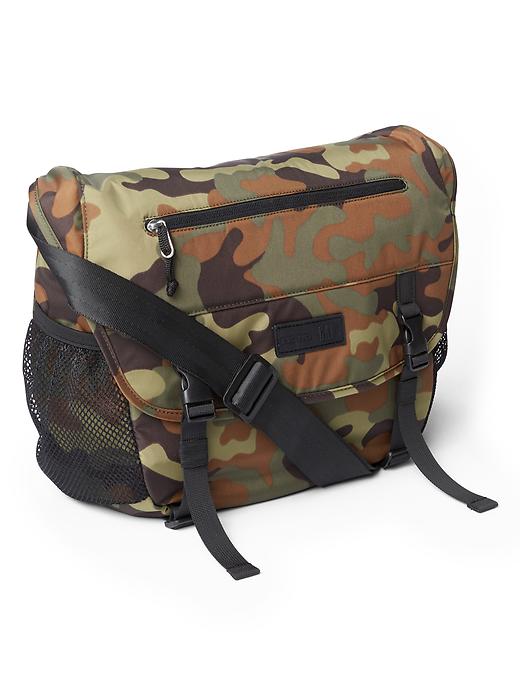
Camo Print Bag, $65, gap.ca
The proliferation of camouflage print each season in fashion would have one think the style posse is perpetually prepping for battle.
The splotchy green, black and tan pattern is a relatively modern warfare invention. Astonishingly, British military wear before the First World War was notice-me red. They would eventually adopt khaki-coloured uniforms, thanks to a regiment of the British Indian Army in 1846, who dyed their white cotton uniforms with mud, curry or tea – the idea being the colour would help them blend in with the dusty landscape of the Indian sub-continent. Thus, khaki became an early example of camouflage clothing in the military.
But during the First World War, the visually disruptive pattern was not used in apparel but – rather as the French did in 1914 – employed to disguise locations, weaponry and other equipment from aerial view. France was the first country to have a military unit consisting of artists and designers, dedicated solely to the artistry and strategy of camouflage. Much of the subject and technique disguises were garnered from Mother Nature and naturalist Abbott Thayer’s 1909 book Concealing Coloration in the Animal Kingdom. The army also borrowed techniques used in the art world – Cubist paintings and trompe l’oeil Renaissance art – in developing ways to subtly fool the eye.
Different camouflage designs and colours were eventually designed according to battle zones, e.g., desert or jungle. And while select units of the army wore camouflage outfits, it wasn’t until 1983 that they sanctioned an official uniform. It was also around that time that American military campaigns began in Grenada and Lebanon, and television coverage helped popularize the print, inspiring teens at home to take it up.
Eventually, by the 2000s, designers such as Jean-Paul Gaultier, John Galliano and Marc Jacobs for Louis Vuitton would use the print in their collections, paving the way for the wide-spread occupation of camouflage in fashion.
Today, the ubiquity of the tactical pattern in all categories of apparel makes it possible to go full commando in camo from head (with hats) to toes (with sneakers). Ironically, the military print that was designed to disguise is now the most visible print in fashion.
RELATED:
Fashion’s Favourite Feline: Leopard Print’s Enduring Legacy